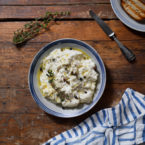Description
This recipe will make between one to two cups of gorgeously creamy, fresh-tasting goat’s milk ricotta cheese.
Ingredients
Units
Scale
- 1 liter (34 fl oz) fresh goat's milk (unpasteurized is preferable, but pasteurized can also work)
- 1/2 teaspoon sea salt
- 3 tablespoons freshly squeezed lemon juice
Instructions
- Prepare Your Equipment: Before you begin, ensure that all your equipment is clean and ready to use. This helps prevent any unwanted bacteria from influencing the cheese-making process.
- Mix Milk and Salt: In a nonreactive saucepan, combine the goat’s milk and sea salt. Mix gently to dissolve the salt completely.
- Heat the Milk: Slowly heat the milk over low to medium heat. Stir occasionally to prevent the milk from scorching on the bottom of the pan. Use a cooking thermometer to monitor the temperature. The goal is to heat the milk to just before boiling, around 185°F – 200°F (85°C – 93°C). Do not let it boil as this can affect the formation of curds.
- Add Lemon Juice: Once the correct temperature is reached, remove the pan from heat. Gently stir in the lemon juice, then allow the mixture to sit undisturbed for 5 minutes. This will help the curds to form. If you do not see curds forming, let it sit for a few more minutes. The acidity and the temperature are crucial for curdling; if your milk is ultra-pasteurized, curdling might be difficult.
- Strain the Curds: Line a colander with a double layer of muslin or cheesecloth and place it over a large bowl. Gently pour the milk mixture into the colander, letting the whey drain away while the curds collect in the cloth.
- Let It Drain: Allow the curds to strain for at least an hour, or until the ricotta reaches your desired consistency. For a firmer ricotta, let it strain longer.
- Refrigerate and Store: Once strained, transfer the ricotta to a container. It can be refrigerated and used within 2-3 days. Pressing the ricotta under a weight in the fridge can further improve its texture, making it denser and more suitable for recipes requiring a firmer cheese.
Notes
- Milk Quality: Fresh, unpasteurized milk works best, but if you only have access to pasteurized milk, try to avoid ultra-pasteurized varieties as they often do not curdle well. See notes further down on how to change the recipe if you need to use ultra-pasteurized milk.
- Acid Source: Lemon juice is preferred for its fresh flavor, but white vinegar can be used as an alternative. The amount might need adjustment based on the milk’s freshness and pasteurization.
- Temperature Control: Keeping the milk at the right temperature is crucial for successful curdling. If curds do not form, the milk may not have been warm enough, or the acid could have been added too early.
- Stirring: Minimal stirring after adding lemon juice is crucial as over-stirring can break the curds.
- Prep Time: 15 mins
- Straining Time: 60 mins
- Cook Time: 10 mins
- Category: Side Dish
- Method: Curdling
- Cuisine: Greek
